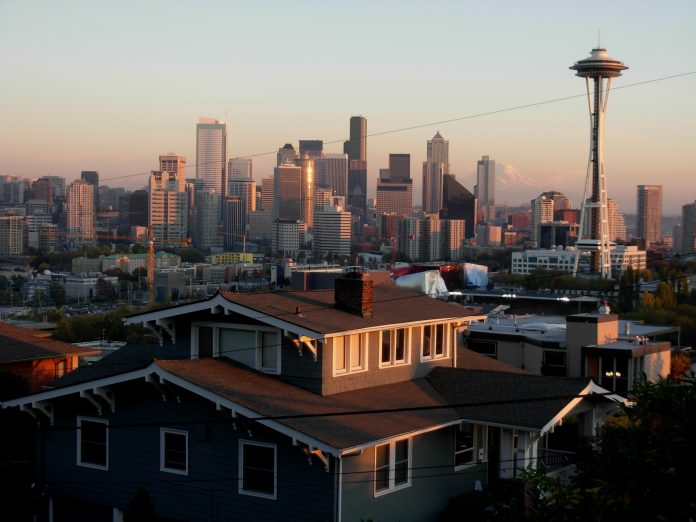So why have affluent neighborhood groups like the Queen Anne Community Council resisted proposed policy changes?
Last week, the City of Seattle released a Racial Equity Toolkit on Policies for Accessory Dwelling Units (ADUs). This Racial Equity Toolkit (RET) was completed to assess if proposed ADU policies would impact some communities differently and included a special focus on race-based disparities. The RET was published in addition to the Environmental Impact Statement (EIS) on ADUs.
The RET found changes to ADU policy would result in race-based disparities, notably that wealthy white homeowners would benefit the most from the proposed policy changes. This comes at a time when an increasing number of homeowners across the US are attracted to the flexibility and income generating potential of ADUs.
Disparities cited in the RET result from longstanding race-based differences in homeownership rates and household incomes in Seattle. Simply put, White households are significantly more likely to own a single-family home and also have the financial resources needed to add an ADU to their property.
Because the City has identified ADUs as a potential tool for both increasing affordable housing stock and curbing displacement of low-income homeowners, it has committed to addressing these racial disparities so that communities of color across the city benefit from new ADU opportunities.
Councilmember Mike O’Brien, whose office sponsored the RET, addressed this challenge at a recent Sustainability and Transportation Council Committee meeting:
“This [ADU] policy has been driven by trying to address broad city goals about trying to create more housing opportunities, and at least for me… it’s not to say, should we do this or not, but instead, what are the impacts? What we learned–and this is not surprising– is that it will benefit wealthier, whiter households. How do we make some changes so that the benefits are shared more broadly? Not if we do this program or not, because it does have broad goals we trying to achieve, but rather what are specific things we can do to tailor it to certain communities so they have as much benefit as other people. That’s going to be tricky.”
Race-Based Disparities in Homeownership and Income
Overall, White residents are more likely to be homeowners than any other racial group in Seattle. Roughly 51% of White households own their homes, while the combined percentage for households of color is 34%, with percentage rates for Native American, Black, and Hispanic hovering around 25%.
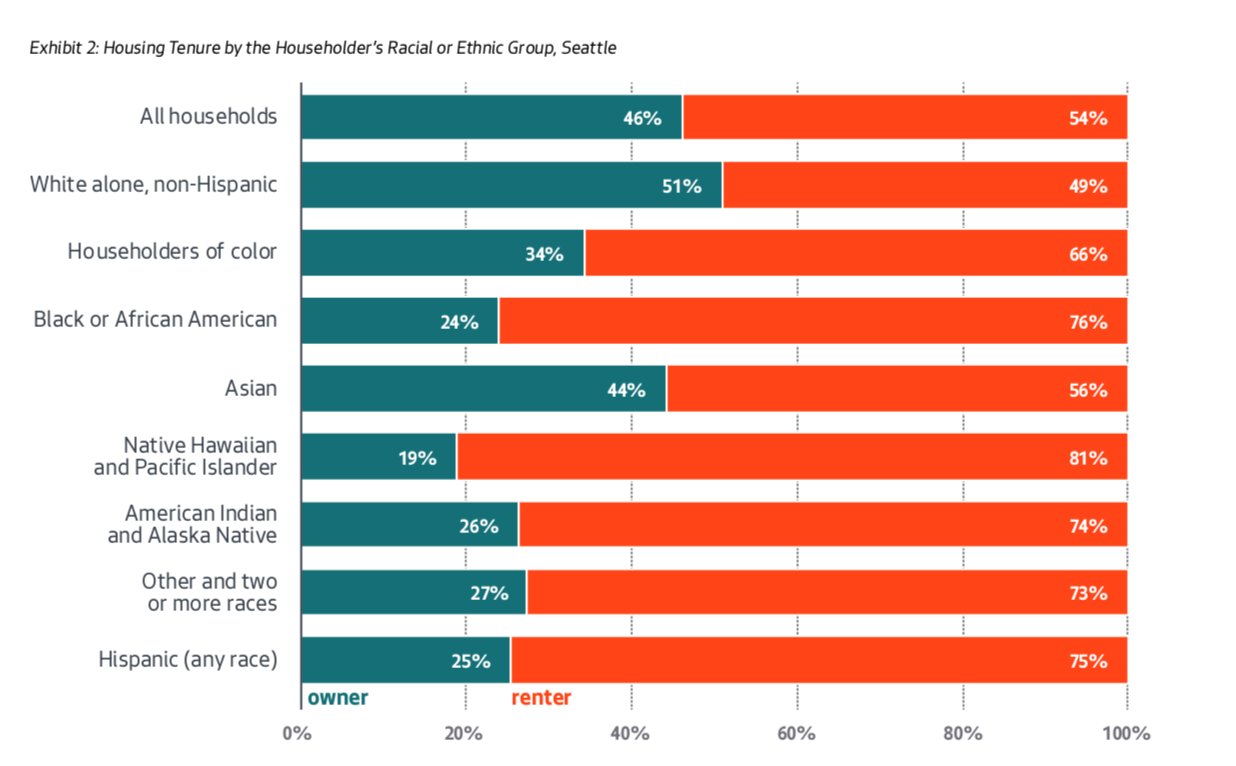
Furthermore, White households are significantly more likely to live in a single-family home than households of color.
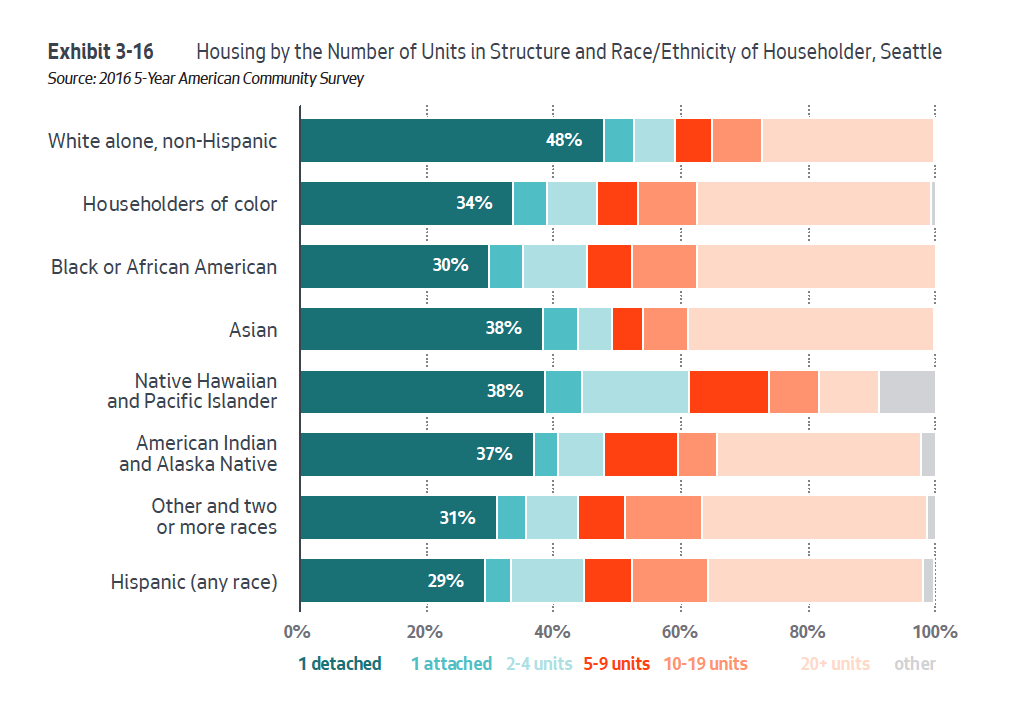
One of the primary factors driving these disparities is household income. Persistent race-based disparities in household income combined with soaring housing costs have made it difficult for households of color to acquire, or in some instances hold onto, single-family homes.
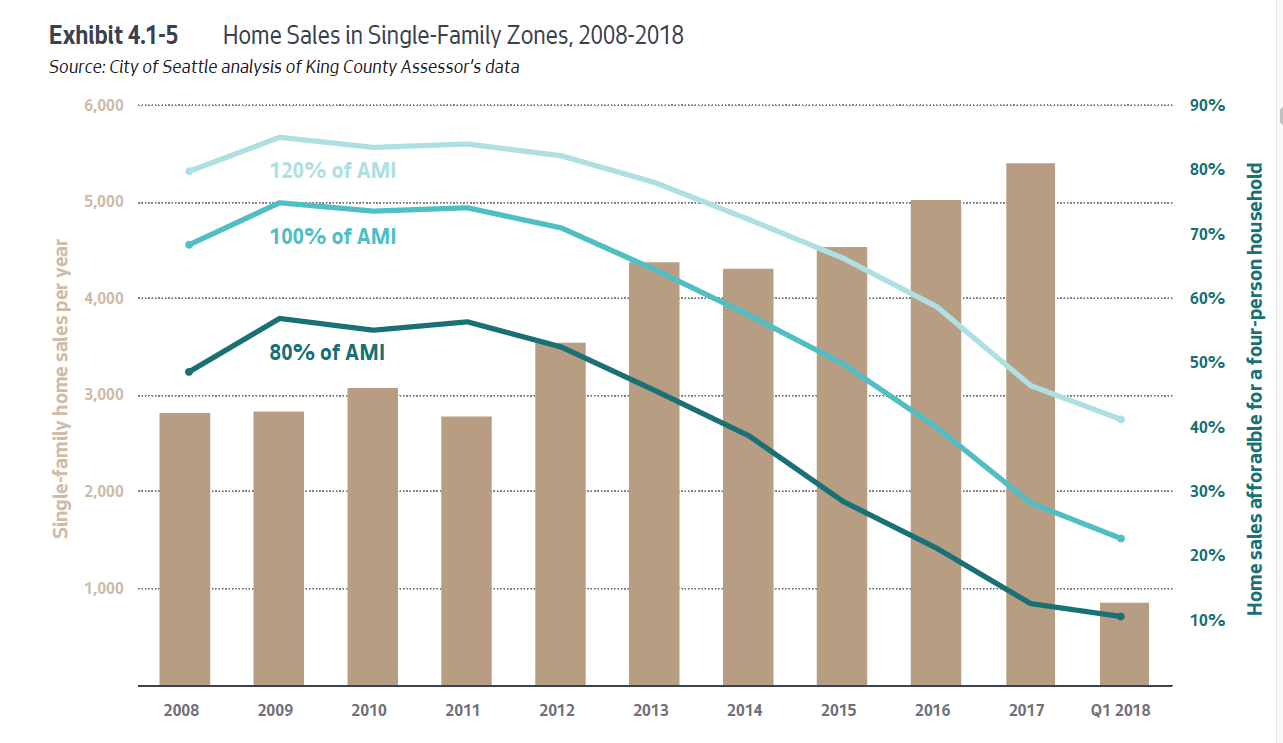
Given our region’s high housing costs, it’s not surprising that single-family home owners in Seattle tend to be high income. According to the RET, the median income for households owning single-family homes is $98,000, while 42% of these households earn more than $120,000.
Only 22% of households owning single-family homes earn $50,000 or less, which is where the median income for Black or African American households falls in the Seattle metropolitan region.
Seattle’s history of racial segregation and redlining also was identified in the RET as having played a role in discrepancies in the single-family home ownership. In Chapter 3 of EIS, which outlines the history and planning of ADUs in context, after the Supreme Court found racial zoning ordinances unconstitutional in 1917, prohibitions on higher-density housing were a common public policy intervention that substituted for racial zoning.
Zoning ordinances separating higher-density residential uses from single-family residential uses were ruled constitutional in the Supreme Court’s 1927 decision Euclid v. Ambler, in which ADUs (defined then as “apartment houses in detached-house sections”) were specifically cited as possible to ban from residential districts.
As a whole, the City of Seattle identifies such zoning policies, along with restrictive lending practices, as having reinforced racial segregation, which prevented people of color from “buying, improving, and developing property and building wealth.”
The shadow cast by these practices continues to loom large. Even in 2018, the consequences of these decisions are still acknowledged by the City as apparent in “patterns that are visible in the study area of this EIS.”
High Upfront Investment Cost
As part of the RET research, a pool of Seattle homeowners who had expressed interest in adding ADUs to their properties were interviewed for feedback about the proposed policy changes. As a whole, these homeowners expressed shock after learning the average price tag of ADU construction.
The City’s estimate of $150,000 for a backyard cottage or detached accessory dwelling unit (DADU) is roughly comparable to industry data, if not a bit low.
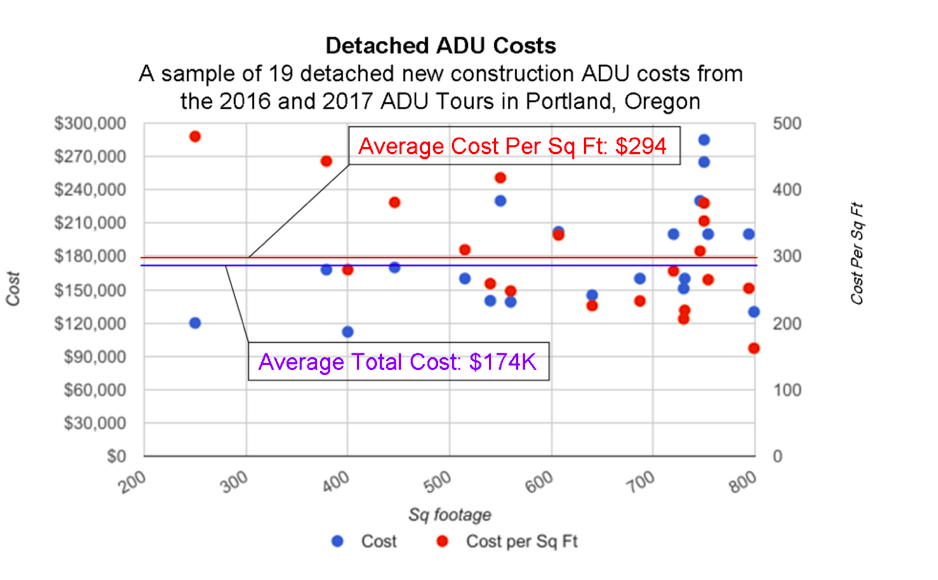
Acknowledging that cities like Austin, Denver, Los Angeles, and Portland have all engaged in programs aimed making ADUs affordable to more homeowners, Seattle is pursuing similar equity based policies.
Some key elements of different programs reviewed included: reducing barriers to backyard cottage construction, making backyard cottages accessible to lower income renters, and resolving issues that may arise with other city departments.
However, as a representative from RET task force noted in the council committee meeting, “The cities we reviewed who are farthest along are still only in the early stages of program development or implementation, and have no more than a few ADUs in the ground.”
Why Have ADU Policy Changes Faced Resistance?
The recent publication of the EIS for proposed changes to ADU policy was brought on by decision made in favor of a 2016 appeal made by the Queen Anne Community Council which demanded the City complete a full EIS before implementing any policy changes. (The full findings and decision for the appeal can be read in Doug Trumm’s 2016 article here.)
Essentially, the Queen Anne Community Council argued that changes to ADU policy such as removing owner residency and parking space requirements, decreasing lot size requirements, and increasing the amount of ADUs permitted on a property would burden things like parking and utility infrastructure, upend the fabric of single family neighborhoods, and create a real estate speculation boom that would accelerate teardown of affordable housing and spike housing costs.
The EIS addresses all of the concerns stated above in great detail, including the fear of teardowns, which the City expects to significantly decrease under its Preferred Alternative in comparison to the current policy.
Additionally, according to the City’s analysis, implementation of the Preferred Alternative would result in 4,430 ADUs between 2020-2027. While this is an increase from current numbers, it pales in comparison to other housing increases already occurring. For example, in 2017 approximately 8,000 residential units were constructed in Seattle, 7,500 of which were built in multi-family developments.
Nonetheless, Marty Kaplan of Queen Anne Community Council has stated that an appeal of the EIS is likely. “I want to read it, but it sounds like the city didn’t consider anything other than where they wanted to go initially,” Kaplan said to the Seattle Times.
The group, and others, have 14 days after publication of the EIS to file an appeal.
What Will Happen Next
With the expectation that an appeal of the EIS will slow down implementation, the City has already created plans for how to address existing racial equity concerns related to ADUs without changing land use codes. Tactics include:
- Using existing homeowner repair loan programs to increase ADUs in homes. The hope to do an initial year pilot that serves 5-10 low income households and builds a better understanding of the needs and interests of people who wish to stay in their homes.
- Conducting outreach with community-based organizations to get the word out about existing and future homeownership programs. $20,000 was proposed for this effort in Mayor Durkan’s 2019/20 budget and an additional $80,000 has been requested by the Office of Housing.
- Exploring options for ADU Affordability work through participation in the Urban Sustainability Accelerator Program. An interdepartmental team will participate a year-long program focused on what can be done to influence the design, location, and use of the ADUs to make progress in meeting community goals for affordability, equity and sustainability.
- Pre-approving backyard cottage/DADU plans independent of land use code changes. The plans would be approved by Department of Construction permitting staff. Pre-approved plans can reduce costs.
According to Councilmember Rob Johnson, if the EIS is not appealed the goal will be to have legislation ready by the end of the year. If an appeal is filed, no council action can be taken until it is resolved. Given the thoroughness of the EIS, Councilmember O’Brien hopes that an appeal would be resolved quickly. “The delay we are talking about is a number of months, not a number of years. We can start doing some work now so the effective delay of a challenge isn’t significant,” Councilmember O’Brien said.
He also stated that any interim period will enable the council to hear more from the public about how the proposed policy can be further “tweaked” to serve the interests of the community.
Natalie Bicknell Argerious (she/her) is a reporter and podcast host at The Urbanist. She previously served as managing editor. A passionate urban explorer since childhood, she loves learning how to make cities more inclusive, vibrant, and environmentally resilient. You can often find her wandering around Seattle's Central District and Capitol Hill with her dogs and cat. Email her at natalie [at] theurbanist [dot] org.

